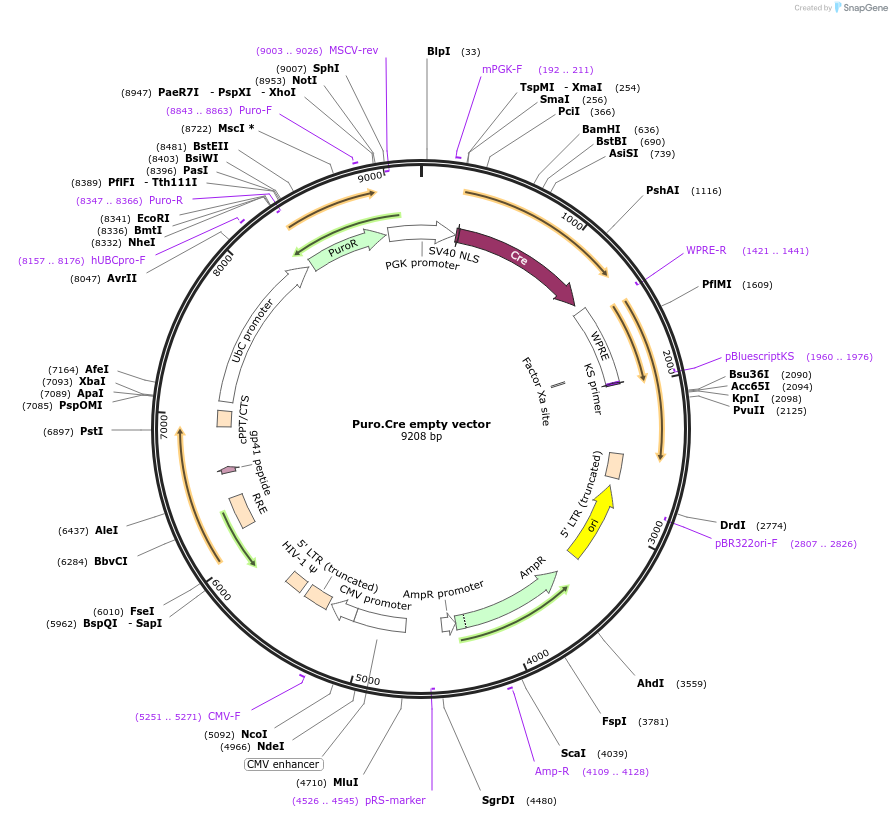-
PurposeLentiviral expression of Cre from the mouse PGK promoter
-
Depositing Lab
-
Sequence Information
Ordering
| Item | Catalog # | Description | Quantity | Price (USD) | |
|---|---|---|---|---|---|
| Plasmid | 17408 | Standard format: Plasmid sent in bacteria as agar stab | 1 | $89 | |
Backbone
-
Vector backbonePuro.Cre
-
Backbone manufacturerJacks Lab
- Backbone size w/o insert (bp) 9200
-
Vector typeMammalian Expression, Lentiviral, Cre/Lox
-
Selectable markersPuromycin
Growth in Bacteria
-
Bacterial Resistance(s)Ampicillin, 100 μg/mL
-
Growth Temperature37°C
-
Growth Strain(s)Stbl3
-
Copy numberUnknown
Gene/Insert
-
Gene/Insert nameCre
- Promoter mouse PGK
Cloning Information
- Cloning method Restriction Enzyme
- 5′ cloning site na (unknown if destroyed)
- 3′ cloning site na (unknown if destroyed)
- 5′ sequencing primer n/a
- 3′ sequencing primer MSCV rev
- (Common Sequencing Primers)
Resource Information
-
A portion of this plasmid was derived from a plasmid made byUbC.Luciferase.PGK.Cre was a kind gift of M. Dupage
-
Articles Citing this Plasmid
Terms and Licenses
-
Academic/Nonprofit Terms
-
Industry Terms
- Not Available to Industry
Trademarks:
- Zeocin® is an InvivoGen trademark.
Depositor Comments
Puro.Cre was initially generated by amplification of PuroR from MSCV.Puro (Clontech) with PuroF (5’-CGCTGCGCCGAATTCATGACCGAGTACAAGCCCACG-3’) and PuroR (5’-TAAGCGGCCGCTCGAGTCAGGCACCGGGCTTGCGGGTC-3’), digestion with EcoRI and NotI and cloning into UbC.Luciferase.PGK.Cre to generate Puro.Cre.
For lentiviral packaging, you can use pCMV-delta-8.2 (Addgene #8455) and pCMV-VSV-G (Addgene #8454).
These plasmids were created by your colleagues. Please acknowledge the Principal Investigator, cite the article in which the plasmids were described, and include Addgene in the Materials and Methods of your future publications.
-
For your Materials & Methods section:
Puro.Cre empty vector was a gift from Tyler Jacks (Addgene plasmid # 17408 ; http://n2t.net/addgene:17408 ; RRID:Addgene_17408) -
For your References section:
Suppression of non-small cell lung tumor development by the let-7 microRNA family. Kumar MS, Erkeland SJ, Pester RE, Chen CY, Ebert MS, Sharp PA, Jacks T. Proc Natl Acad Sci U S A. 2008 Mar 11;105(10):3903-8. doi: 10.1073/pnas.0712321105 10.1073/pnas.0712321105 PubMed 18308936



